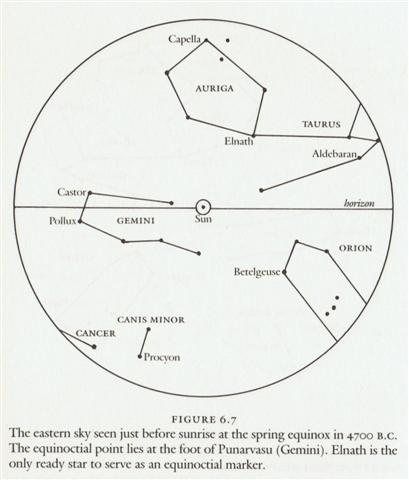A quarter of a year counted from the heliacal rising of Sheratan (β Arietis) - and also from the beginning of the nakshatra calendar (in April 17 = day 107 of the Gregorian calendar) - the immortal twin Pollux (β Gemini) rose with the Sun:
The extraordinary glyph Cb4-19 - strongly drawn to ensure notice - has a position not only corresponding to (in rongorongo times) the heliacal rising of Pollux but also to right ascension day 300 in the night, which date could be ascertained by observing the bright (0.76) Altair close to the Full Moon. Metoro here said tagata noho i to mea - a person (tagata) who is residing in (noho i) something called to mea. The little word to was associated with the path of sun up to zenith, but also with building a canoe from planks:
... They go inland at the land. The child nursed and tended grows up, is able to go and play. Each day he now goes off a bit further away, moving some distance away from the house, and then returns to their house. So it goes on and the child is fully grown and goes to play far away from the place where they live. He goes over to where some work is being done by a father and son. Likāvaka is the name of the father - a canoe-builder, while his son is Kiukava ... As to mea it could be close in meaning to kahi (9 days earlier): ... Rangitokona, prop up the heaven! // Rangitokona, prop up the morning! // The pillar stands in the empty space. The thought [memea] stands in the earth-world - // Thought stands also in the sky. The kahi stands in the earth-world - // Kahi stands also in the sky. The pillar stands, the pillar - // It ever stands, the pillar of the sky. Then for the first time was there light between the Sky and the Earth; the world existed ... Once upon a time (taketake) the light of spring would have returned when Gemini rose with the Sun:
The pair of hanau glyphs at the end of line Cb4 are probably connected with the measure 383½ (= 13 * 29½) and with the position 180º away from July 18-19:
Metoro said tagata instead of hanau (birth) at this pair of glyphs and probably his intention was to underline that it was the date visible in the night sky which should be considered -because the precise dates around a solstice had to be found by the nakshatra method (Sun was useless because he did not move) - and that these hanau glyphs were at the opposite side of the sky compared to the end of the lunar year (defined by 13 synodic lunar nights counted from January 1 in the previous year). | |||||||||||||||||||||||||||||||||||||||||||||||||||||||||||||||||||||||||||||||||||||||||||||||||||||||||||||||||||||||||||||||








